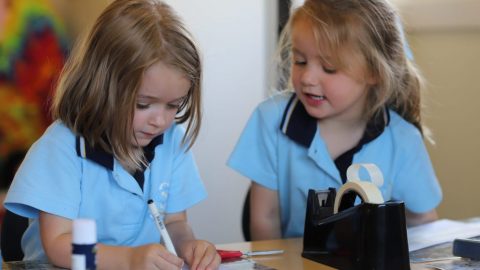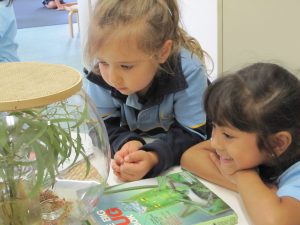Learning to Communicate

Communication is an integral part of our Early Learning Centre (ELC) curriculum. From birth, children begin to learn to communicate with others for a range of purposes. They are intrinsically motivated to share their ideas, thoughts, questions and feelings, and to use a range of tools and media to express themselves and connect with others. When children become part of a language-rich group learning environment they begin to implement all aspects of their communication.
Through our early learning programs, we aim to work towards developing the children’s communication skills and understandings and assist them to become effective communicators in a range of contexts.
Outcome 5: Children are effective communicators:
- Children interact verbally and non-verbally with others for a range of purposes.
- Children engage with a range of texts and gain meaning from these texts.
- Children express ideas and make meaning using a range of media.
- Children begin to understand how symbols and pattern systems work.
- Children use information and communication technologies to access information, investigate ideas and represent their thinking.
Literacy and numeracy capabilities are important aspects of communication and are vital to successful learning across the curriculum. Literacy and numeracy experiences are richly embedded in our early learning programs. It is critical that these experiences are relevant and meaningful in the context of the children’s lives.
“Positive attitudes and competencies in literacy and numeracy are essential for children’s successful learning. The foundations of these competencies are built in childhood.” – Early Years Learning Framework for Australia.
Literacy is the capacity, confidence and disposition to use language in all of its forms. Literacy incorporates a range of modes of communication including music, movement, dance, storytelling, visual arts, media and drama. It also includes electronic and print based media. Children are exposed to a range of books and texts within the program. Print is displayed within the classroom learning environments and children have opportunities to engage with stories, learn songs, rhymes, poems and play with words. Children engage in regular conversation and discussion with their peers and educators. They learn the roles of listening and speaking and develop an understanding that conversation is a reciprocal exchange.

The St Catherine’s Early Learning Centre aims to work towards developing the children’s communication skills.
Numeracy is the capacity, confidence and disposition to use Mathematics in daily life. Children are provided with play and inquiry-based opportunities to explore and learn more about the concepts of number, shape, pattern, measurement, classification, time, currency and space. It is important that children have opportunities to apply these understandings to everyday contexts so that they learn how these understandings apply to daily life.
Technology is integrated into the children’s play, experiences and inquiries. The children learn new skills and techniques on how to use technology and develop an understanding that technology can be used for exploring new information. The use of technology is not isolated, it is interactive as small groups of children and educators collaborate. Technology is integrated into the program for a specific purpose or a specific inquiry.
The frequent conversations and discussions echoing from the ELC classrooms are testament to the richness of the opportunities that are designed to enhance the children’s communication skills and assist them to become effective communicators over time.
School Holiday Break
I would like to take this opportunity to wish our ELC families a happy Easter. I hope that you have a safe and relaxing holiday break. We look forward to the children returning to Campbell House for the commencement of Term 2 on Tuesday 23 April.


